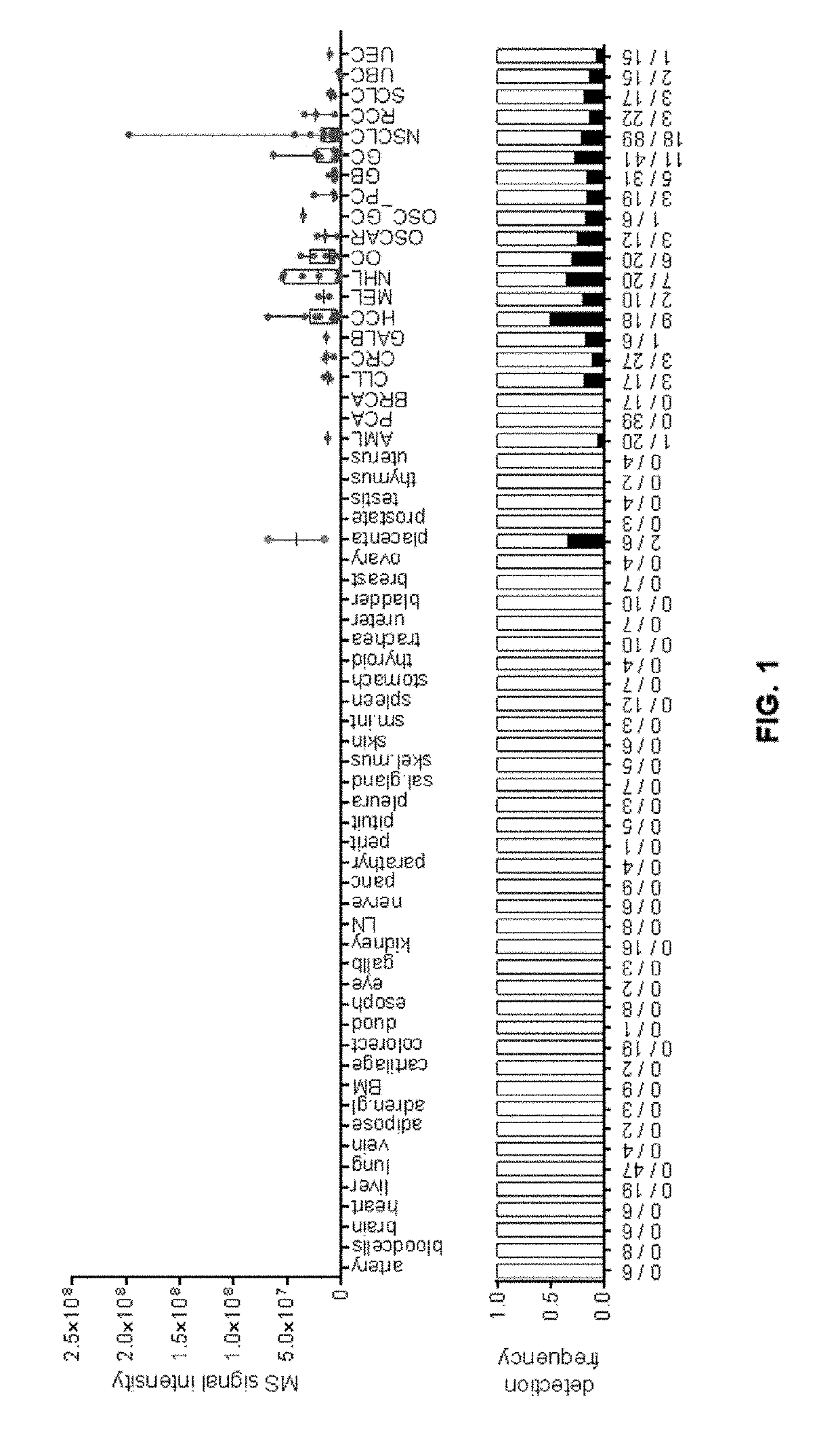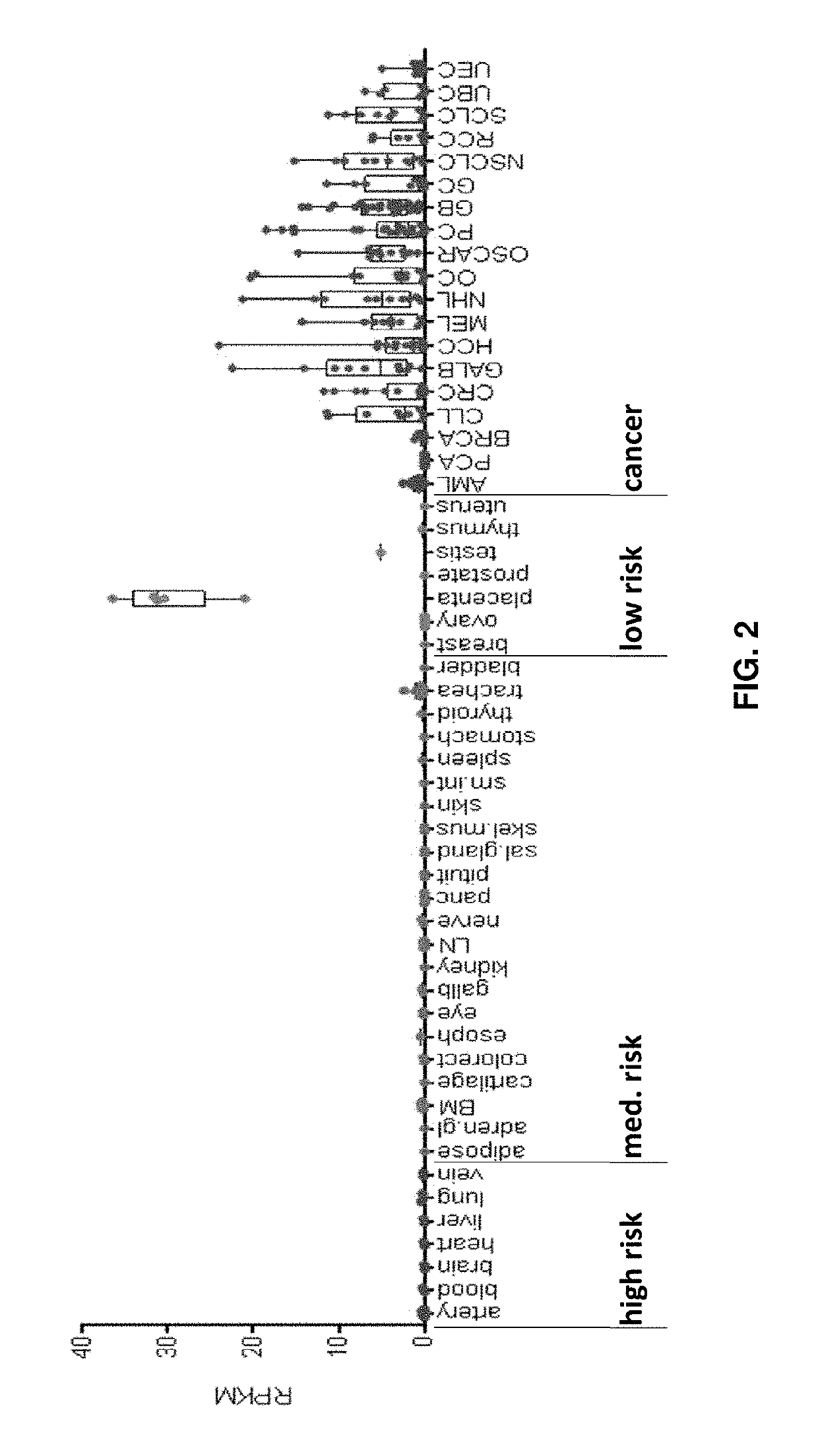Peptides and combination of peptides for use in immunotherapy against cancers
a cancer and immunotherapy technology, applied in the field of peptides and combinations of peptides, can solve the problems of high patient risk of local and systemic relapse, high risk of recurrence, and the second most common cause of death of stomach cancer, and achieve the effect of enhancing the stability or solubility of peptides
- Summary
- Abstract
- Description
- Claims
- Application Information
AI Technical Summary
Benefits of technology
Problems solved by technology
Method used
Image
Examples
example 1
[0231]In vitro generation of allo-HLA reactive, peptide-specific T-cells (Savage et al. 2004) PBMCs from HLA-A*02-positive and HLA-A*02-negative healthy donors were used after obtaining informed consent. Recombinant biotinylated HLA-A2 class I monomers and A2 fluorescent tetramers containing IGF2BP3-001 were obtained from MBLI (Woburn, Mass.). PBMCs were incubated with anti-CD20SA diluted in phosphate buffered saline (PBS) for 1 hour at room temperature, washed, and incubated with the biotinylated A2 / IGF2BP3-001 monomers for 30 minutes at room temperature, washed, and plated at 3×106 cells / well in 24-well plates in RPMI with 10% human AB serum. Interleukin 7 (IL-7; R&D Systems, Minneapolis, Minn.) was added on day 1 at 10 ng / mL and IL-2 (Chiron, Harefield, United Kingdom) was added at 10 U / mL on day 4. Over a 5-week period cells were restimulated weekly with fresh PBMCs, mixed with responder cells at a 1:1 ratio, and plated at 3×106 / well in 24-well plates.
[0232]To obtain high avidit...
example 2
f TCRs
[0233]Methods of cloning TCRs are known in the art, for example, as described in U.S. Pat. No. 8,519,100, which is hereby incorporated by reference in its entirety for said methods. The alpha chain variable region sequence specific oligonucleotide A1 (ggaattccatatgagtcaacaaggagaagaagatcc SEQ ID NO:11) which encodes the restriction site NdeI, an introduced methionine for efficient initiation of expression in bacteria, and an alpha chain constant region sequence specific oligonucleotide A2 (ttgtcagtcgacttagagtctctcagctggtacacg SEQ ID NO:12) which encodes the restriction site SalI are used to amplify the alpha chain variable region. In the case of the beta chain, a beta chain variable region sequence specific oligonucleotide B1 (tctctcatatggatggtggaattactcaatccccaa SEQ ID NO:13) which encodes the restriction site NdeI, an introduced methionine for efficient initiation of expression in bacteria, and a beta chain constant region sequence specific oligonucleotide B2 (tagaaaccggtggcc...
example 3
s T-Cell Engineering
[0243]T-cells can be engineered to express high avidity TCRs (so-called TCR therapies) or protein-fusion derived chimeric antigen receptors (CARs) that have enhanced antigen specificity to MHC I / IGF2BP3-001 complex or MHC II / IGF2BP3-001 complex. In an aspect, this approach overcomes some of the limitations associated with central and peripheral tolerance, and generate T-cells that will be more efficient at targeting tumors without the requirement for de novo T-cell activation in the patient.
[0244]In one aspect, to obtain T-cells expressing TCRs of the present description, nucleic acids encoding the tumor specific TCR-alpha and / or TCR-beta chains identified and isolated, as described in Examples 1-2, are cloned into expression vectors, such as gamma retrovirus or lentivirus. The recombinant viruses are generated and then tested for functionality, such as antigen specificity and functional avidity. An aliquot of the final product is then used to transduce the targe...
PUM
 Login to View More
Login to View More Abstract
Description
Claims
Application Information
 Login to View More
Login to View More - R&D
- Intellectual Property
- Life Sciences
- Materials
- Tech Scout
- Unparalleled Data Quality
- Higher Quality Content
- 60% Fewer Hallucinations
Browse by: Latest US Patents, China's latest patents, Technical Efficacy Thesaurus, Application Domain, Technology Topic, Popular Technical Reports.
© 2025 PatSnap. All rights reserved.Legal|Privacy policy|Modern Slavery Act Transparency Statement|Sitemap|About US| Contact US: help@patsnap.com



